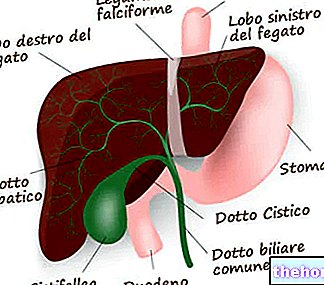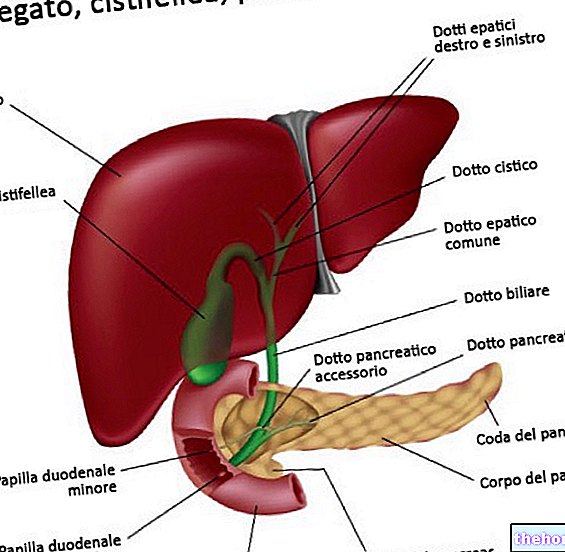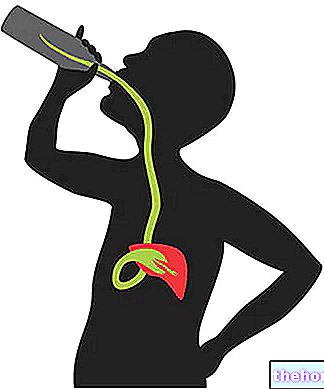Generality
Cirrhosis of the liver is a chronic and degenerative disease of the liver.
It occurs when the organ responds to an injury or a morbid process by destroying its own cells and replacing them with scarring interconnections, between which nodules of regenerating cells develop; consequently, the liver gradually loses its architecture and functions, with negative repercussions on the whole organism.

Causes
Anything that causes chronic liver damage can cause cirrhosis; among the main causes of this disease we find viral hepatitis (B, C and D) and autoimmune ones, alcohol abuse (which in industrialized countries is the most common cause of cirrhosis) or certain drugs, some metabolic diseases (steatosis non-alcoholic liver disease, glycogenosis, hemochromatosis, Wilson's disease), occlusion of the bile ducts (due to stones, inflammatory processes or tumors) and circulatory stasis in the liver (which characterizes chronic heart failure).
Instead, we speak of cryptogenic cirrhosis when the cause of origin is not determinable.
Potential Causes of Fibrosis and Cirrhosis of the Liver
- Chronic viral hepatitis (HBV and HCV)
- Toxic (e.g. alcohol or drugs)
- Autoimmune liver disease (autoimmune hepatitis)
- Metabolic diseases (Hemochromatosis, Wilson's disease)
- Parasitic diseases (eg Schistosomiasis)
- Non-alcoholic steatohepatitis
- Vascular changes (congenital or acquired)
- Diseases of the biliary tract (primary sclerosing cholangitis)
Due to the aforementioned pathological situations, the liver finds itself in a chronic inflammatory state, which leads to the release of certain substances (called cytokines); in turn these substances favor the proliferation of fibrous tissue (liver fibrosis) and - in the most advanced stages - lead to the development of regeneration nodules typical of cirrhosis.
Symptoms and Complications
For further information: Symptoms Cirrhosis of the liver
For the central role that the liver plays in regulating the body metabolism, and for the pathological alterations associated with the disease, cirrhosis determines dramatic consequences for the patient; these include:
- portal hypertension (the nodules oppose the normal hepatic circulation, so the blood can return to the portal vein * increasing the pressure; thus, intra and extrahepatic collateral circulation is formed, through which the blood pours directly into the outflow ducts without entering in contact with the hepatic parenchyma; portal hypertension therefore reduces the blood flow to the still functioning liver cells, resulting in the appearance in the circulation of toxins normally inactivated by the organ and a decrease in the substances synthesized by it);
- jaundice (yellowing of the skin due to accumulation of bile pigments in the blood);
- splenomegaly (enlarged spleen);
- varices (esophageal and hemorrhoidal);
- edema, ascites (accumulation of extracellular fluid in the abdominal cavity, particularly conspicuous in patients with decompensated cirrhosis) and water retention, muscle and testicular atrophy, gynecomastia, hepatic encephalopathy, hair loss and the appearance of bruising and bleeding (all conditions caused by the decrease in liver function - with reduced synthesis of albumin, coagulation factors and proteins - associated with a decrease in detoxifying and metabolic capacity in general).
(*) the portal vein collects all the blood that comes from the digestive tract, the spleen, the pancreas and the gallbladder, and transports it to the liver; from here it passes to the inferior vena cava which carries it to the heart.
Cirrhosis of the liver - Video: Causes, Symptoms, Cures
Problems with playing the video? Reload the video from youtube.
- Go to the Video Page
- Go to Wellness Destination
- Watch the video on youtube
Cirrhosis and Liver Cancer
Cirrhosis is also a major risk factor for hepatocellular cancer (see liver cancer).
Fortunately, in principle, hepatic damage occurs with a slow progression, through stages that can in any case follow one another more rapidly in certain situations (for example due to the possible overlapping of several aggravating factors).
Care
For further information: Medicines for the treatment of Cirrhosis
The absolute ban on alcohol (as a general rule and in particular in the presence of alcoholic cirrhosis), the restriction in the use of certain drugs, therapy with specific anti-inflammatory drugs (in the presence of chronic hepatitis), the surgical removal of the obstruction ( in case of secondary biliary cirrhosis) and the pharmacological treatment of heart failure, can stop the progression of the disease, which otherwise evolves inexorably until the patient dies.
Diet
For further information: Diet and Cirrhosis
The adoption of particular dietary measures - variable according to the stage of cirrhosis - is extremely important; for example, we tend to limit the intake of sodium (especially if ascites is present), poorly tolerated foods (fried foods and other difficult to digest) and coarse (which can traumatize esophageal varices), often resorting to dietary supplements (for example lactulose, fiber, probiotics and prebiotics - to control constipation and improve intestinal bacterial flora - and, in the presence of advanced stage decompensated cirrhosis, branched-chain amino acids in association with a low-protein diet).
Prevention
Despite the impossibility of treating it, the disease is susceptible of effective prevention; many cases of cirrhosis are in fact linked to alcohol abuse (especially in industrialized nations) and viral hepatitis (more common in underdeveloped countries).
For the prevention of liver cirrhosis it is therefore very important:
- moderation or abstention from alcohol consumption;
- vaccination against viral hepatitis (vaccines are available for hepatitis A, B, D and E), the use of condoms in case of occasional intercourse and the abstention from consuming contaminated water or food when traveling to countries in way of development.
Cirrhosis - Medicines for the treatment of Cirrhosis »




























